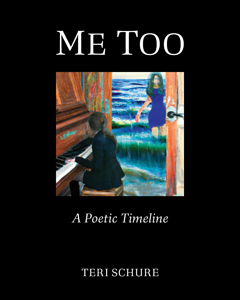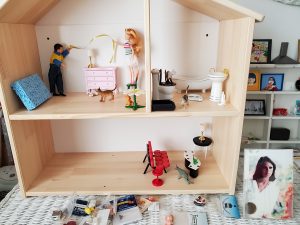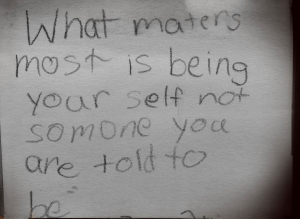As the self-anointed queen of verbiage, I recognize that this blog post is way too long, but I hope you stick with it to the end.
According to Grammarly, my “productivity is skyrocketing,” and I’m “lapping the competition.” They also praised me, saying, “You’ve been busy wrangling words like a pro and building a reputation for stellar productivity.”
(FYI, I’ve been “wrangling” way more than words lately, but okay.)
According to Grammarly, 29% of my most recent wordsmithing was “Joyful.” Joy isn’t something I usually express, so Grammarly’s assertion gave me…joy!
Grammarly has also published numerous articles explaining that joy is a tricky emotion to express and encouraging writers to:
Express joy without feeling guilty about it.
Hmmm. Joy. Now that’s an emotion I should think about beefing up on for 2026.
Another thing Grammarly got me thinking about, which is:
I doubt I’m “lapping the competition,” and anyway, I have no idea who my competition might be.
As far as “building a reputation for stellar productivity,” I’m not sure how Grammarly could know that, even though, according to them, they have analyzed over 108 million of my words since my blog launched in 2015.
So, I suppose they can affirmatively attest to the fact that I write incessantly, but there is zero chance they know whether I am producing stellar work or not.
I am my own worst critic, forever doubting the quality of my writing, which is why my visitor and page-view statistics are so crucial to me.
Are the thousands of visitors and page views each month an indication that my work is good? I don’t know, but I’d like to think so, and it would give me much joy, since I express myself much better in writing than in speaking, which is why I spend so many hours in solitary writing confinement.
And anyway, without writing, I’m only a tiny sliver of a person. You see, it’s my writing that keeps me sane and makes me whole. My family is my everything, but my writing is what pushes me to survive and thrive.
I’ve never been much of a public speaker; however, I’ve recently discovered that I feel very comfortable reciting my poetry and other works in front of an audience. My latest self-indulgence is participating in poetry open mics.
But don’t get me wrong—I’m not afraid to speak my mind. One of my go-to lines about myself is, “You may not like what I have to say, but you’ll always know where I stand.”
Mostly because I feel compelled to stand up for myself, my boundaries, and my expectations, which has led to more than my share of lost friendships and family relationships.
But I’m not sorry, because my feeling is this: I expect two-way relationships, so if I give and you don’t give back, I’m out. But not before I say my piece.
I tend to speak out the loudest through my writing, which I find to be the least offensive way to speak up and out, not just about what I want to say, but what I have to say.
More often than not, I have no idea what I’m going to say until it hits me. There’s no planning involved, just an unplanned journey into the unknown depths of my psyche.
And sometimes I start writing one thing, only to end up with something altogether different! I have surmised that my unconscious has a will of its own.
I scrutinize every word as if trying to piece together a black-on-black jigsaw puzzle, and no post is ever final, which drives me crazy.
Whatever “piece” I had to say in 2015, 2020, 2024—or whenever—is always in a state of perpetual flux.
Years after writing a post, I often find myself rewriting, revising, and (hopefully) improving upon it. Each piece I create is a stark reminder that my thoughts, moods, and opinions are ever-changing. As such, my words (and opinions) are never final because they are forever fluid.
And now, for The Teri Tome’s top five blog posts of 2025:
#1 IN 2025:

FOUR THOUSAND WEEKS: Rooted in the disquieting yet straightforward fact that the average lifespan is finite, Oliver Burkeman’s bestselling book Four Thousand Weeks: Time Management for Mortals reminds us that life’s brevity is undeniable.
Since our time on earth is limited, Burkeman reminds us to make the most of the time we have left.
Four thousand weeks equal 76.923 years, so if Burkeman is correct, that leaves me with about four years (208 weeks) to get sh*t done. Welp!
#2 IN 2025:

ME TOO: A POETIC TIMELINE: Me Too: A Poetic Timeline is my latest publication and, hands down, my proudest writing achievement, mainly because I get to share a subject with my readers that is rarely openly discussed.
I spent over 15 months putting this book of poetry together without telling anyone in my family, not even my husband, that I was writing it. Because, no rhyme intended, but speaking out about “Me Too” is sadly taboo.
And to be brutally honest, no one in my family has ever had a conversation with me about my childhood abuse, my MeToo trauma, or this book of poetry.
Do I think my children, husband, and other family members know about Me Too and me? Of course they do. But I’m sure my loved ones don’t know what to say, because most people don’t.
But not me. I stayed quiet for far too long, so I’ve got plenty to say.
…and say…and say…
And while I am terrified of speaking out, I constantly remind myself that, instead of crowning David king, God gave him Goliath.
#3 IN 2025:

HAPPILY EVEN AFTER: As a wordsmith, I know that one word can change a life, a relationship, or a sentence.
One word. That’s all it takes.
In this case, it was a sentence on my daughter’s bridal shower cake about life being happily…
EVEN vs. EVER after.
Some would have taken the message as a bad omen, i.e.,
HAPPILY EVEN AFTER…WHAT?????
I took it as a sign that the baker was a bad speller.
And the message I got from it was: NEVER to order a cake from that bakery again.
#4 IN 2025:

CAN MY BROKEN RELATIONSHIPS DUE TO ANTI-ISRAEL SENTIMENTS EVER BE REPAIRED?: I was so happy this post made it to the top five, mainly so I could reiterate my revulsion and profound disapproval of anyone who has used their words to fuel, entice, invite, give credence to, and enable despicable haters to bully, harass, and target INNOCENT JEWS. So the answer to my titled question is NO.
I originally wanted to title this post: Can My Broken Relationships Due to Jew-hating Ever Be Repaired? Unfortunately, at the time, I decided to go light on the Jew-haters.
Now that I’m even angrier about the Jew-baiting and hating, I would love to update the title, but the post is already getting so many thousands of page views that I dare not make any changes. I most definitely don’t want my readers to click on a post I absolutely need them to read only to get a 404 error page instead.
And anyway, I think, or at least I hope—title change or not—that I’ve made my disgust and disappointment loud and clear.
#5 IN 2025:

MY STOLEN DIARIES—CHAPTER 32: FROM RAGS TO RICHES: I was also happy that this post made the top five because it serves as a reminder that bullying is a pattern of behavior, not an isolated incident, and that it almost always involves a real or perceived power imbalance.
You know, go after the minority, the weakest link, the ones who are different.
People who bully usually come from a “perceived” higher social status, i.e., popular, athletic, pretty, or legends in their own minds. So it came as no surprise to me that some of my Jew-hating “Facebook” friends (disguised as anti-Zionists) were the same hateful kids who bullied me in high school!
I initially intended to title this chapter “From Rags to Bitches.” After leaving Bridgeport for Westport, I was bullied ferociously by both girls and boys, so it wasn’t appropriate to single out the females, since both genders were equally complicit and venomously mean.
But try as they might, their bullying and cruelty didn’t break me—it only made me stronger and more resolved to survive their malice.
And I suppose I owe those bullies at Bedford Junior High and Staples High School a debt of gratitude, because they helped me recognize that poverty trauma gave me a superpower those rich, clueless, bratty, and entitled kids could never understand.
And now…imaginary drum roll, please…
The Top Five G.O.A.T.T.T.:
(The Greatest Of All Teri Tome Time: 2014-2025)
#1 OF ALL TERI TOME TIME:

BLUE MIND: I was shocked that this post, written on April 15, 2021, about the theory “Blue Mind,” reached the G.O.A.T.T.T., not just by a little, but by thousands upon thousands of page views.
For those who know me, being in or travelling on water is not my thing. And yet I love sitting beside it, even though my heart races a gazillion times a minute.
I love it when my heart beats almost out of my chest because I liken each palpitation to clapping hands. A heartfelt “inner applause,” cheering me on, and rooting for me; for my fears, for my tears, and for all the people I’ve lost and YES, for all the people I’ve gained.
Proof that my beating heart isn’t broken—but alive and well.
#2 OF ALL TERI TOME TIME:

THE PAM PROJECT: This blog post, written on December 6, 2021, has generated over 10,000 page views, and I know without a doubt that my cousin Pam would be incredibly proud of it and of me.
She was always my biggest fan, and I feel confident that every time someone reads something I have written about Pam, her legacy shines on.
A legacy is so much more than birthing others, although, to me, the miracle of creation is the most valid proof of life after death.
But a legacy can also be etched in words, creating a memory, every time someone shares a story about that person.
A reminder that I don’t want my name carved on a gravestone. I want my name etched in the hearts and minds of the people I love and cherish.
And for those whom I love from afar, who, unfortunately, never got the chance to know and love me, I hope you read my words one day, so you will see for yourself that you have always been in my heart.
I am hopeful that, when I am long gone, my writings will resonate, allowing me, like Pam, to live on.
And to my dear cousin Pam, whom I miss terribly: I pray you are resting in peace and waiting for me on the other side.
#3 OF ALL TERI TOME TIME:

MY STOLEN DIARIES DISCLAIMER: I wrote this post on January 12, 2020, the day I made the final decision to upload my dusty old stored-away novel onto my blog, one chapter at a time.
I wrote the disclaimer at my editor friend’s insistence to serve as a legal shield and protect me from potential lawsuits. So I did it, but to be clear,
A) If anyone happens to see themselves in any of the characters, that’s on them and a figment of their overly imaginative imagination.
And
B) BRING IT ON.
#4 OF ALL TERI TOME TIME:

THE FATES AND THE FURIES: I penned this post on February 3, 2019, during a politically rough time, though I didn’t know then that things were about to get way, way rougher.
On that day, while many others were busy preparing for Super Bowl parties, I watched the television coverage of two protests:
1) In the U.S., protesters were urging immigrants to skip work, school, and spending, protesting recent anti-immigrant policies and increased ICE enforcement under the Trump administration.
2) The massive anti-government protests in Venezuela, fueled by opposition leader Juan Guaidó’s declaration as “acting president” and a European ultimatum for new elections.
In both cases, it was the significant participation of women that struck me the most.
I watched as brave U.S. protesters—many of them women—shut down lanes of the 101 Freeway in L.A. while carrying signs opposing the administration’s immigration policies and ICE actions.
In Venezuela, many women were dressed in white, expressing desperation over hunger and a lack of medicine, while security forces responded with violence.
In Greek mythology, the Fates and the Furies (all female goddesses) were not to be messed with—and they wielded the ultimate girl power.
The Fates and the Furies were six powerful, badass women who embodied divine order and law—my kind of girls. After watching the protests in the U.S. and Venezuela, I decided to write about these personifications of destiny.
#5 OF ALL TERI TOME TIME:

MY STOLEN DIARIES—CHAPTER 16: IN OVER MY HEAD: I posted this Chapter on February 19, 2023, even though I had written it more than 30 years earlier.
According to Idioms by the Free Dictionary, “In Over My Head” means: “Too deeply involved in or with a difficult situation, beyond the point of being able to control or cope any longer.”
I would agree with the “too deeply involved” part, but not with the “beyond the point of coping.” My way of coping is to write it out, and that’s my best way of letting my readers know where I stand. Although, haven’t we all been “in over our heads” at one time or another in our lives?
And now for my hope for 2026, but first, I have to look back on 2025.
I can only speak for myself, but 2025 was a particularly tough year—much tougher than I expected it to be—and one I am ecstatically happy is now over.
Not to say that for me, wonderful and blessed events didn’t happen in 2025, because they did.
But the spewing of hate in 2025 was heartbreakingly visceral, and it felt incredibly personal in so many ways, and from so many loved ones, because sadly, it often was.
The only constant in 2025 was WTF? FROM ALL SIDES.
I’m praying for a more peaceful and calm 2026, because honestly, I’ve had my fill of all the hatefulness.
So here is my 2026 New Year’s Resolution:
Be a flame. Globalize the light. Globalize the love.
And somehow, some way, stop the haters dead in their tracks.



